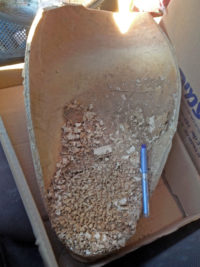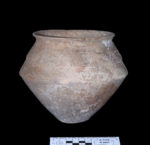 Archaeologists with the Israel Antiquities Authority (IAA) have discovered a jar containing the skeletal remains of at least nine frogs, all of them headless, in a Canaanite tomb outside Jerusalem. The discovery was made three years ago during an archaeological excavation in advance of development in the Minhat neighborhood near the Jerusalem Biblical Zoo. In 2014, the IAA team’s exploration unearthed an intact tomb from the Canaanite period, about 4,000 years ago during the Middle Bronze Age. It contained several clay vessels of different shapes and sizes, some undamaged and in exceptional condition.
Archaeologists with the Israel Antiquities Authority (IAA) have discovered a jar containing the skeletal remains of at least nine frogs, all of them headless, in a Canaanite tomb outside Jerusalem. The discovery was made three years ago during an archaeological excavation in advance of development in the Minhat neighborhood near the Jerusalem Biblical Zoo. In 2014, the IAA team’s exploration unearthed an intact tomb from the Canaanite period, about 4,000 years ago during the Middle Bronze Age. It contained several clay vessels of different shapes and sizes, some undamaged and in exceptional condition.
According to [IAA excavation directors Shua Kisilevitz and Zohar Turgeman-Yaffe]: “For an archaeologist, finding tombs that were intentionally sealed in antiquity is a priceless treasure, because they are a time capsule that allows us to encounter objects almost just as they were originally left. At that time, it was customary to bury the dead with offerings that constituted a kind of “burial kit,” which, it was believed, would serve the deceased in the afterworld. When we removed the stone that blocked the tomb opening, we were excited to discover intact bowls and jars.
“In one of the jars, to our surprise, we found a heap of small bones. The study of the bones, by Dr. Lior Weisbrod of the University of Haifa, revealed at least nine toads. Interestingly, they had been decapitated.”
 The study also identified material from plants, including date palms and myrtles, in samples taken from inside the clay vessels. These could only have been transferred into the jars shortly before they were buried in the tomb. Date palms and myrtles are not native to the area, so the Canaanites must have planted the trees themselves.
The study also identified material from plants, including date palms and myrtles, in samples taken from inside the clay vessels. These could only have been transferred into the jars shortly before they were buried in the tomb. Date palms and myrtles are not native to the area, so the Canaanites must have planted the trees themselves.
According to Dr. [Dafna Langgut of Tel Aviv University], in this period the date palm symbolized fertility and rejuvenation, which could explain why the ancients cultivated the trees in this environment, where they do not grow naturally. According to the scholars, these plants may have been part of an orchard planted in an area where funeral rituals were held, during which offerings of food and objects were made to the deceased. The scholars surmise that the jar with the headless toads was among these offerings.
This video from the IAA YouTube channel is in Hebrew with no English subtitles, alas, but it’s well worth watching even if you can’t understand the commentary because there’s cool footage of the intact vessels and the broken one filled with frog bones being recovered from the tomb. You can see how challenging it was to get into the narrow, deep space. IAA archaeologist David Tanami had to be upside-down and almost completely vertical to reach the opening.
The study’s findings will be presented on October 18th at the “New Studies in the Archaeology of Jerusalem and its Region” conference held at the Hebrew University of Jerusalem. The presentation is open to the public.
Ummm…. Toad-In-The-Hole, my favorite breakfast!
———————————-
Next we have No. 4 – “Crunchy Frog”. Am I right in thinking there’s a REAL frog in here?
A: We use only the finest baby frogs, dew picked and flown from Iraq, cleansed in finest quality spring water, lightly killed, and then sealed in a succulent Swiss quintuple smooth treble cream milk chocolate envelope and lovingly frosted with glucose.
That’s as may be — it’s still a frog. Don’t you even take the bones out?
A: If we took the bones out, it wouldn’t be crunchy, would it?
———————————-
:confused:
[Monty Python’s Flying Circus]
They will be your uncommon headless frog, which I know exist because I have seen the internet videos.
Youtubeque sunt vera!
Can anyone explain how the tomb was built and where the deceased was placed? ~ Thanks!
It was one of 67 man made shaft tombs. I.e. Long and narrow
And yes Livius, some of us can understand the Hebrew audio. But all that was said was just what you wrote.
Hope to be able to attend the October conference. And please, folks, no toads in my grave.
More online at: The Times of Israel
Sept 25 edition
Thanks for the article. Finding a well-preserved site is always exciting, particularly one with odd rituals (headless frogs being one of them.) The article about the possible Viking boat burial was interesting. Have you thought about perhaps following up with a post describing Viking burial practices in general? If you wanted, you could be specific and write about a particular city (such as Trondheim) and what it looked like during the Viking era.
Thank You for your consideration,
JF
Well are they frogs or toads? Can’t think of a reason for frogs in the afterlife, but certain toads have poison glands near their ears that if one were to bite their head off, one would probably hallucinate. Of course, you could just suck the toad ( yes kiddies, look it up, it’s a real thing), but that’s not as badass as a crunchy bite. Could have been part of a burial ritual- hallucinating during the wake to see the dead off, maybe ask them where the treasure is buried.